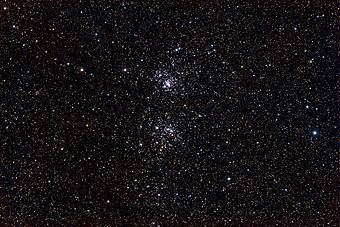Magnitude 9.23 Apparent magnitude (V) 9.23 | ||
 | ||
Similar VX Sagittarii, RW Cephei, KW Sagittarii, Rho Persei | ||
S Persei is a red supergiant located near the Double Cluster in Perseus, north of the cluster NGC 869. It is a member of the Perseus OB1 association and one of the largest known stars. It is also a semiregular variable, a star whose variations are subject to more irregularities than those of Mira variables.
Contents
Discovery
S Persei was named by German astronomer Adalbert Krueger in 1874 after observing that it varied in brightness. It was subsequently listed in major stellar catalogues of that era as HD 14528, BD+57 552.
Variability
S Persei varies slowly by several magnitudes, a factor of over 40 in brightness. It has a main period of somewhat over two years, but shows significant unpredictability. There is a strong variation in the amplitude from around one magnitude to about four magnitudes, and these have been interpreted as beats due to a second period of about 940 days. Other analyses find only the primary period of 813 ± 60 days.
S Persei is classified as a semiregular variable star of type SRc, indicating that it is a supergiant, and it has one of the largest visual amplitudes of any variable of this type. While the General Catalogue of Variable Stars lists it as varying between magnitudes 7.9 and 12.0, it has since been seen fainter.
The spectral type of S Persei also varies. Typically it is a red supergiant of spectral class M3 or M4, but particularly at deep visual minima it may show a much cooler spectral type of M7 or M8, highly unusual for a supergiant.
Properties
Many of the visually bright variable stars belong to this class of semiregulars, as these stars are extremely large and luminous, and hence visible across long distances. S Persei could be as large as 1,230 times the sun's radius (R☉), but is most likely to be "only" 780 R☉. It has been described as a hypergiant. Its angular diameter has been measured directly and found to be somewhat elliptical. Modelled as a uniform disk, the diameter corresponds to 1,200 R☉.
The temperature has been calculated from the spectrum using a DUSTY model, giving an effective photospheric temperature of 3,600 K and a temperature of 900 K for the surrounding dust torus. This is consistent with previous studies, but the derived luminosity from different authors varies from 86,000 L☉ to 186,000 L☉. Older studies frequently calculated higher luminosities and lower temperatures.
The mass of S Persei is also uncertain, but expected to be around 20 M☉. Mass is being lost at 6994679999999999999♠6.8×10−6 M☉ per year, leading to an extensive and complex circumstellar environment of gas and dust.
Location
S Persei is surrounded by clouds containing water molecules which produce maser emission. This allows the distance to be measured very accurately using very long baseline interferometry, giving an annual parallax of 0.413 ± 0.017 milliarcseconds. For comparison the Hipparcos parallax is 1.88 mas, but the margin of error is larger than the parallax value itself. It lies somewhat further away than the centres of the Double Cluster open clusters, but definitely within the Per OB1 association and the Perseus Arm of the galaxy.
S Persei is a double star. The red supergiant has an A0 11th magnitude companion at 69". There are also several other 8th to 10th magnitude stars within half a degree of S Persei.
